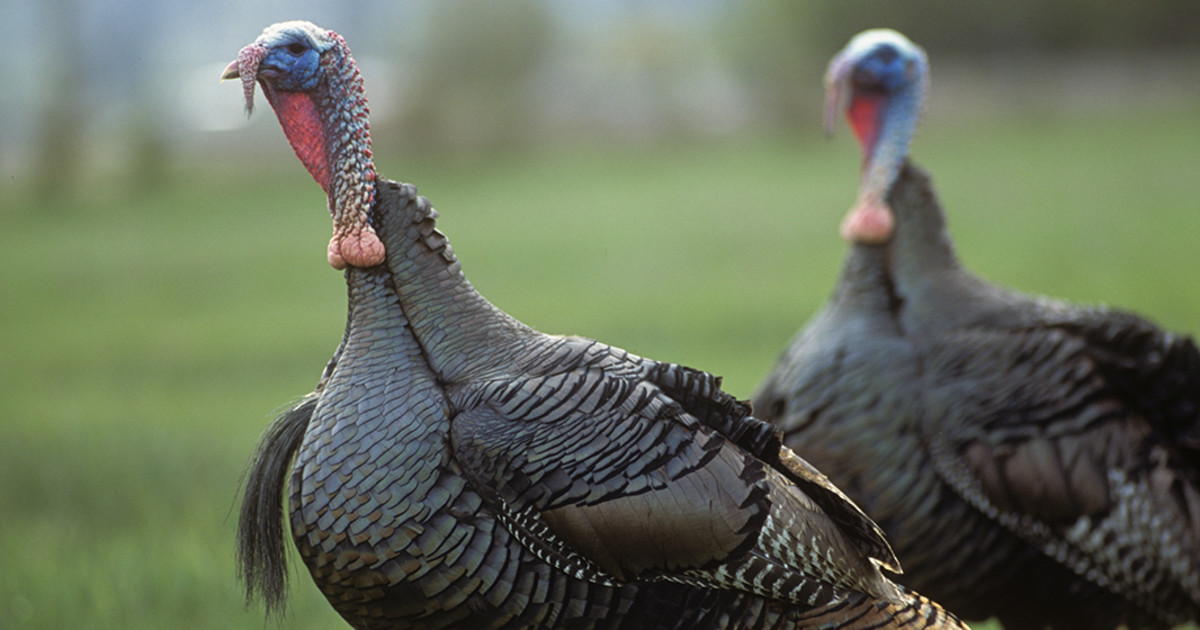To identify a red-tailed hawk compared to a turkey vulture and red-shouldered hawk, look for a distinctive red tail with a dark band towards the end as well as a brown body and wings. The red-tailed hawk, scientifically known as buteo jamaicensis, is a bird of prey commonly found in north america.
It’s a large bird with a broad, rounded tail and a wingspan of up to 56 inches. Correctly identifying different hawks can be challenging, particularly as some species share similar features. In this article, we’ll make it easy for you to learn how to distinguish a red-tailed hawk from other species such as the turkey vulture and red-shouldered hawk.
Follow these four easy steps, and you’ll never confuse these magnificent birds again!

Credit: www.themeateater.com
Step 1: Identify Basic Physical Characteristics
Description Of The Red-Tailed Hawk’S General Appearance
The red-tailed hawk (buteo jamaicensis) is a magnificent bird of prey, widely considered the most common hawk species in north america. With a wingspan of up to four feet, they are one of the largest varieties of hawks. They have broad wings, a rounded body, and a medium-length tail.
Their wings are typically brown, with a distinctive reddish-brown tail that tapers to a point.
Key Features To Note, Such As Size, Distinctive Coloring, And Shape Of Beak And Tail
The red-tailed hawk has several key features that make them easily distinguishable, including:
- Size: With a wingspan of up to four feet, the red-tailed hawk is one of the largest hawks in north america.
- Coloring: They have brown wings, a white to cream-colored chest and belly, and a distinctive reddish-brown tail.
- Beak: Their beaks are sharp and curved, designed specifically for tearing flesh and grasping prey.
- Tail: Their tails are long, tapered, and reddish-brown, earning them their name.
Explanation Of Why Understanding Basic Physical Characteristics Is Important For Bird Identification
Understanding the basic physical characteristics of a bird like the red-tailed hawk is crucial for accurate identification. Not only does it allow you to distinguish it from other similar-looking birds like the turkey vulture and the red-shouldered hawk, but it also helps you identify it quickly and confidently, especially when observing birds in the wild.
Knowing the key features such as size, distinctive coloring and shape of beak and tail, allows for easy and accurate identification of this majestic bird. So, never underestimate the power of understanding basic physical characteristics while identifying birds.
Step 2: Pay Attention To Flight Patterns And Behavior
Red-tailed hawks are commonly found in north america and are famous for their distinct rust-colored tails. To correctly identify them, one must consider a few factors such as size, shape, and coloration. However, there are other crucial aspects to pay attention to during bird-watching trips.
In the following section, we will discuss step 2 of identifying a red-tailed hawk, which involves observing flight patterns and behavior.
Different Ways Red-Tailed Hawks Fly, Including Soaring And Gliding
Red-tailed hawks have a distinctive flight pattern compared to other birds of prey. They use thermal air currents to soar high and glide seamlessly across the sky. Here are some things to keep in mind while observing their flight patterns:
- Red-tailed hawks glide with their wings held in a dihedral shape, creating a “v” shape.
- They often soar in a circular motion, making it easier to spot them from a distance.
- When soaring, they frequently fan their tails to stabilize themselves.
How To Identify A Red-Tailed Hawk’S Behavior, Such As Hunting And Territorial Displays
Apart from their flight pattern, the behavior of red-tailed hawks is also indicative of their identification. To avoid mistaking them for other similar species, it is essential to watch their behavior closely for the following traits:
- Hunting: Red-tailed hawks perch patiently on trees or poles, waiting for their prey to show up. Once they spot their target, they swoop down with remarkable speed and agility.
- Territorial displays: Male red-tailed hawks engage in dramatic aerial displays to impress their female counterparts. They display their speed and agility by flying in loops, hovering, and diving.
Explanation Of Why Flight Patterns And Behavior Are Important For Bird Identification, And How They Can Help Differentiate Red-Tailed Hawks From Other Birds Of Prey
Observing the flight patterns and behavior of birds is crucial to identify them correctly. Different birds have distinct flight patterns and behaviors, providing clues to their identification. Red-tailed hawks’ dihedral shape, v posture during soaring, and fanned tails distinguish them from other raptors.
Similarly, their hunting style and territorial displays are unique to their species and help differentiate them from other similar birds.
Identifying red-tailed hawks can be tricky, but observing their flight patterns and behavior makes it easier. Next time you’re out bird-watching, keep in mind the key points mentioned in this section and identify these magnificent birds like a pro!
Step 3: Listen For Vocalizations
Description Of Red-Tailed Hawk Vocalizations, Including Calls And Screams
Red-tailed hawks are known for their distinct vocalizations. They communicate with calls and screams, each with its unique purpose. Here are the different vocalizations of a red-tailed hawk:
- Screech: This call is a short and piercing sound, indicating an alert or warning to other hawks about potential danger.
- Scream: This high-pitched and shrill sound is usually heard when a red-tailed hawk is defending its territory or attacking its prey.
- Whistle: This soft and melodious call is used by red-tailed hawks as a form of courtship during breeding season.
Tips For Differentiating Red-Tailed Hawk Vocalizations From Those Of Other Birds
It is essential to differentiate red-tailed hawk vocalizations from other bird species to avoid identification confusion. Here are some tips:
- Understand the difference in pitch: Red-tailed hawk vocalizations are generally high-pitched and have a distinct tone compared to other birds.
- Pay attention to the context: The circumstances surrounding the sound can also help differentiate the bird species. Red-tailed hawks vocalize when hunting, feeding, mating, or defending their territory.
- Practice listening: Train your ears by listening to red-tailed hawk vocalizations online or in the wild.
Explanation Of Why Listening For Vocalizations Is Important For Bird Identification.
Listening for vocalizations is crucial in bird identification, especially when the bird is not visible. Here are some reasons why:
- Vocalizations are the primary communication method among birds and can help identify bird species.
- Bird vocalizations vary depending on time, habitat and season, providing additional clues for the bird’s detection.
- Certain bird species have unique vocalizations, making their identification even more straightforward.
By paying attention to the distinct vocalizations of birds like the red-tailed hawk, identifying and appreciating the beauty of the world’s avian species becomes much more accessible.
Step 4: Consider Habitat And Range
Overview Of The Typical Habitat And Range Of Red-Tailed Hawks
Red-tailed hawks are one of the most widely distributed hawks in north america. They are often found soaring in open fields, meadows, and along highways. These birds can be seen in varying altitudes, from ground level to over 10,000 feet in the air.
Red-tailed hawks typically avoid densely forested areas but are comfortable in areas with scattered trees or shrubs. They can be found across the united states, canada, and mexico, and do not migrate, so they can be seen year-round.
How To Identify A Bird’S Habitat Based On Its Surroundings
Identifying a bird’s habitat can be a helpful tool in identifying the bird itself. When trying to identify a bird’s habitat, pay attention to the following:
- Climate and weather patterns: Certain types of birds prefer specific climates and weather conditions.
- Altitude: Different bird species thrive at different altitudes.
- Geographic features: Nearby bodies of water, forests, grasslands, and mountains can all affect a bird’s habitat.
Knowing these factors can help birdwatchers identify a particular species’ habitat and narrow down the search.
Examples Of Other Birds That May Share Similar Habitats, And How To Differentiate Between Them
Many birds share the same habitat as red-tailed hawks, making it important to know how to differentiate between them. Here are some examples:
- Turkey vulture: Also found soaring above open fields, but has a much larger, darker body and more prominent wingspan than the red-tailed hawk.
- Red-shouldered hawk: Similar in size to the red-tailed hawk, but prefers wetter, more forested areas.
- Bald eagle: Larger than the red-tailed hawk and prefers to live near large bodies of water.
Knowing the distinguishing characteristics of these birds can help birdwatchers identify the correct species.
Explanation Of How Considering Habitat And Range Can Assist With Bird Identification
Considering habitat and range can help birdwatchers identify a particular species. By knowing the typical habitat and range of a bird, it can help narrow down the search and avoid confusion with similar species that live in different areas. This can make the identification process quicker and more accurate, especially when dealing with species that have overlapping ranges or similar physical characteristics.
Overall, understanding a bird’s habitat and range can be a helpful tool for any birdwatcher looking to identify a specific species.
Frequently Asked Questions On “How To Identify A Red Tailed Hawk In 4 Easy Steps ● Compare Vs Turkey Vulture, Red Shouldered Hawk And More”
What Is A Red Tailed Hawk And What Does It Look Like?
A red tailed hawk is a large bird of prey with reddish-brown feathers, a pale breast and a distinctive red tail. They have broad wings and sharp talons.
How Big Is A Red Tailed Hawk?
The red tailed hawk has a wingspan of up to 56 inches and can weigh up to 3. 5 pounds. Females are larger than males.
Where Can I Find Red Tailed Hawks?
Red tailed hawks can be found throughout north america in a variety of habitats including fields, forests, deserts and mountains. Look for them perched on trees or soaring high in the sky.
What Is The Difference Between A Red Tailed Hawk And A Turkey Vulture?
Red tailed hawks have reddish-brown feathers, a red tail and sharp talons, while turkey vultures have black feathers and a featherless, red head. Red tailed hawks hunt for prey, while turkey vultures primarily eat carrion.
How Can I Identify A Red Tailed Hawk In Flight?
Look for the broad wings and rounded tail of a red tailed hawk in flight. They often soar in circles or spirals and can be identified by their distinctive red tail feathers.
Conclusion
After reading this article, you should now be well equipped to identify a red-tailed hawk in just four easy steps. Remember to look for the distinct characteristics of the hawk such as its red tail, dark belly band, and broad wingspan.
Be mindful of the differences between other birds of prey such as the turkey vulture, red-shouldered hawk, and cooper’s hawk which have similar features but vary in size, shape, and coloration. By using the knowledge and skills you have gained through this article, you can confidently identify red-tailed hawks in the wild.
Keep practicing and honing your bird identification skills, and you will soon become an expert. Finally, don’t forget to enjoy the beauty of nature and the diverse bird species around you.
Latest Posts
The Ultimate List: Top 8 Best Birdwatching Podcasts for Avid Birders
Looking for the top birdwatching podcasts? Here are the eight best options to tune into today! Birdwatching can be a thrilling, immersive experience that brings...
Stop Squirrels in Their Tracks: 10 Effective Ways to Safeguard Your Bird Feeder Pole
To prevent squirrels from climbing your bird feeder pole, use squirrel baffles and slippery poles. Here are ten effective ways to keep squirrels from stealing bird food and damaging bird feeders. ...


